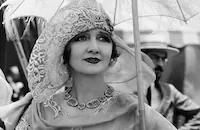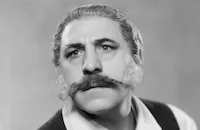Speak Easily

Brief Synopsis
Cast & Crew
Edward Sedgwick
Buster Keaton
Jimmy Durante
Ruth Selwyn
Thelma Todd
Hedda Hopper
Film Details
Technical Specs

Synopsis
Serious-minded professor Timoleon Zanders Post yearns for the carefree life that his students enjoy, but is too timid to change. His kindly butler Jenkins decides to help the professor by showing him a phony letter saying that Post has just inherited $750,000. Relieved that he no longer has to scrimp and save, Post immediately withdraws his savings and embarks on an adventure. Though Jenkins soon worries that he did the wrong thing, Post's superior at the college, Dr. Rayburn, tells Jenkins that it's the best thing that could have happened to the repressed young professor. At the train station, Post meets a troupe of vaudevillians and is immediately smitten with one of the performers, Pansy Peets. She is impressed with his politeness and intellectual conversation and asks him to write to her. He also strikes up a friendship with James Dodd, the act's comic. After being stranded at the train's next stop, Post goes to see the troupe's act and is so impressed that he decides to finance a Broadway show for them. They then go to Broadway and start rehearsals, under the direction of Rayburn, who is frustrated by the troupe's monumental lack of talent. Rayburn then hires Eleanor Espere, a blonde bombshell, who takes an interest in Post and convinces the naive professor that it is customary for the star to give the show's owner the key to her apartment and expect him to pay the rent. On the night before the show opens, Eleanor lures Post to her apartment, dons a flimsy negligee and gives him a cocktail. He becomes slightly intoxicated and soon begins mixing his own concoctions. Several hours later, both he and Eleanor are so drunk that they can hardly stand and innocently wind up spending the night together in her bedroom. In the morning, when they awaken, Eleanor accuses Post of taking advantage of her, and pretends to be shocked when "her brother" knocks on the door. Actually, the man is a friend of Eleanor's whom she has asked to come at the right moment to blackmail Post into proposing to her. Fortunately for Post, when Pansy and James realize where Post has been all night, James rushes over to Eleanor's and switches places with his friend. That morning, a lawyer arrives at the theatre and tells James that the professor's inheritance is non-existent, and that several bill collectors are threatening to close the show before it opens. Hoping to prevent this, James tries to keep Post away from the theater so he can't be served with any injunctions. Nothing works, however, and all through the performance Post keeps stumbling onto the stage. Despite Rayburn's near hysteria at Post's interruptions, the audience thinks that he is the star of the show and laughs uproariously. Realizing that the show is a hit, a big Broadway producer offers Post $100,000 for half interest in the show and the bill collector happily goes away. Finally, when Eleanor sees Post kissing Pansy, he is compelled to explain the situation by resorting to the unscholarly phrase, "Nuts to you!"

Director

Edward Sedgwick
Cast

Buster Keaton

Jimmy Durante

Ruth Selwyn

Thelma Todd

Hedda Hopper
William Pawley

Sidney Toler

Lawrence Grant

Henry Armetta

Edward Brophy
Crew
Arthur Appell
Nacio Herb Brown
Arthur Freed
Cedric Gibbons
Laurence E. Johnson
Buster Keaton
William Levanway
Anstruther Macdonald
Charles Maxwell
Douglas Shearer
David Snell
Ralph Spence
Earl Taggart
Harold Wenstrom

Film Details
Technical Specs

Articles
Speak Easily
At MGM, Keaton was placed under the supervision of producer Lawrence Weingarten, who had no understanding of Keaton's kind of comedy. Weingarten and MGM head Louis B. Mayer decided to try to make a team out of Keaton and Jimmy Durante. The two comics, whose styles were vastly different, appeared in three films together: The Passionate Plumber (1932), Speak Easily (1932), and What! No Beer? (1933). Of the three, the only one Keaton had anything good to say about was Speak Easily.
In Speak Easily, Keaton plays a quiet college professor who mistakenly believes he's inherited a fortune. The professor cuts loose, backs a seedy theatrical troupe headed by Durante, and falls in with a hard-drinking gold digger, played by Thelma Todd. A talented comedienne who could hold her own with such comic geniuses as the Marx Brothers, Laurel and Hardy, and Zasu Pitts, Todd proved an excellent foil for Keaton. And while Keaton's and Durante's styles did not really mesh, Keaton wrote in his autobiography, "He was very good in the one picture we made together that had quality. I think this was because the character he played was very much like the real Jimmy Durante. The picture was Speak Easily, which...had a sound comedy plot."
Durante had great respect for Keaton, and according to Keaton, he proved it in the films they did together. "I could see that MGM was grooming Durante. He knew it too - but he stole no scenes." Durante also proved his loyalty during and after the production of Speak Easily. It was a terrible time in Keaton's life. His marriage to Natalie Talmadge was breaking up, he was drinking heavily, and he either wouldn't show up for work, or would be so hung over that he couldn't function. The production went over budget at least in part because of Keaton's absences and ill health. According to Jhan Robbins' biography of Durante, Inka Dinka Doo, when the film was finished, the stars were expected to appear at a press conference. Durante showed up; Keaton didn't. Durante tried to cover up for Keaton by telling the press that his co-star had a bad cold. But the next day, the studio sent Keaton a telegram firing him. Durante went to Mayer and pleaded with him, managing to get Keaton reinstated. It was only a temporary reprieve. After What! No Beer? Buster Keaton and MGM parted company. Ignominiously, he was re-hired by the studio as a gag writer a few years later. But Keaton was discovered by a new generation in the 1950's, and continued to work in films until his death in 1966.
Todd's tragic and mysterious end came in 1935, when she was found dead of carbon monoxide poisoning in her car in a closed garage. Her death was ruled a suicide, but it was rumored that she had been murdered on the orders of mobster Lucky Luciano. She was only 30 years old.
Director: Edward Sedgwick
Producer: Buster Keaton
Screenplay: Laurence E. Johnson, from the novel Footlights, by Clarence Budington Kelland
Cinematography: Harold Wenstrom
Editor: William LeVanway
Art Direction: Cedric Gibbons
Principal Cast: Buster Keaton (Professor Timoleon Zanders Post), Jimmy Durante (James "Jimmy" Dodge), Ruth Selwyn (Pansy Peets), Thelma Todd (Eleanor Espere), Hedda Hopper (Mrs. Peets), William Pawley (Griffo), Sidney Toler (Stage Director).
BW-82m.
by Margarita Landazuri

Speak Easily
Quotes
Trivia
Notes
Clarence Budington Kelland's novel was first serialized in Saturday Evening Post under the title Footlights (6 February-12 March 1932). Although a copyright statement appears on the opening title card of the film, it is not listed in the copyright registry. According to modern sources, delays on the production of this film caused increased production costs that eventually led to a $33,000 loss on the picture. Because of the loss, M-G-M production head Irving Thalberg forced Buster Keaton to take a 30% pay cut on his next picture, What-No Beer? to offset the studio's costs. For additional information on that film, please consult entry below.














